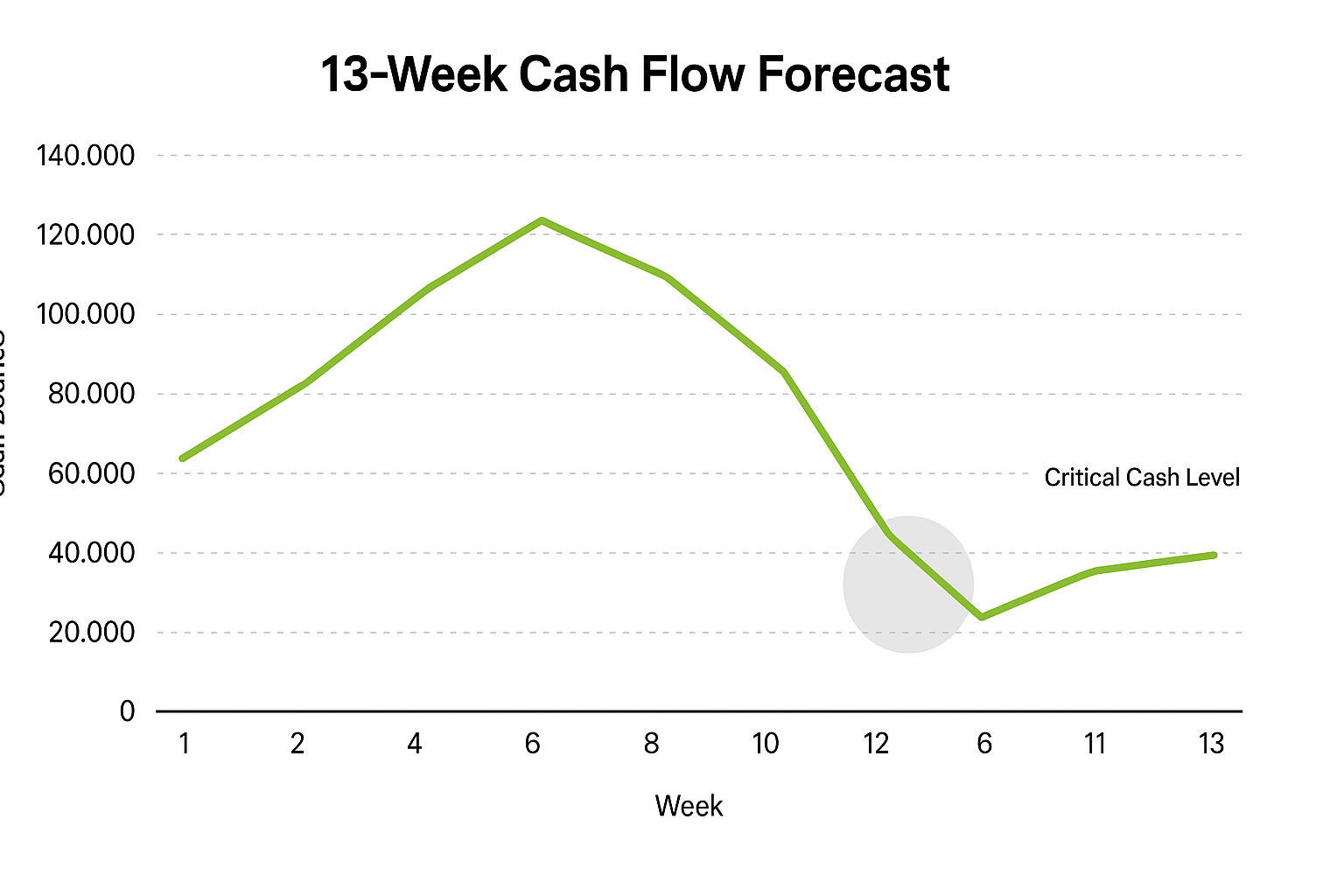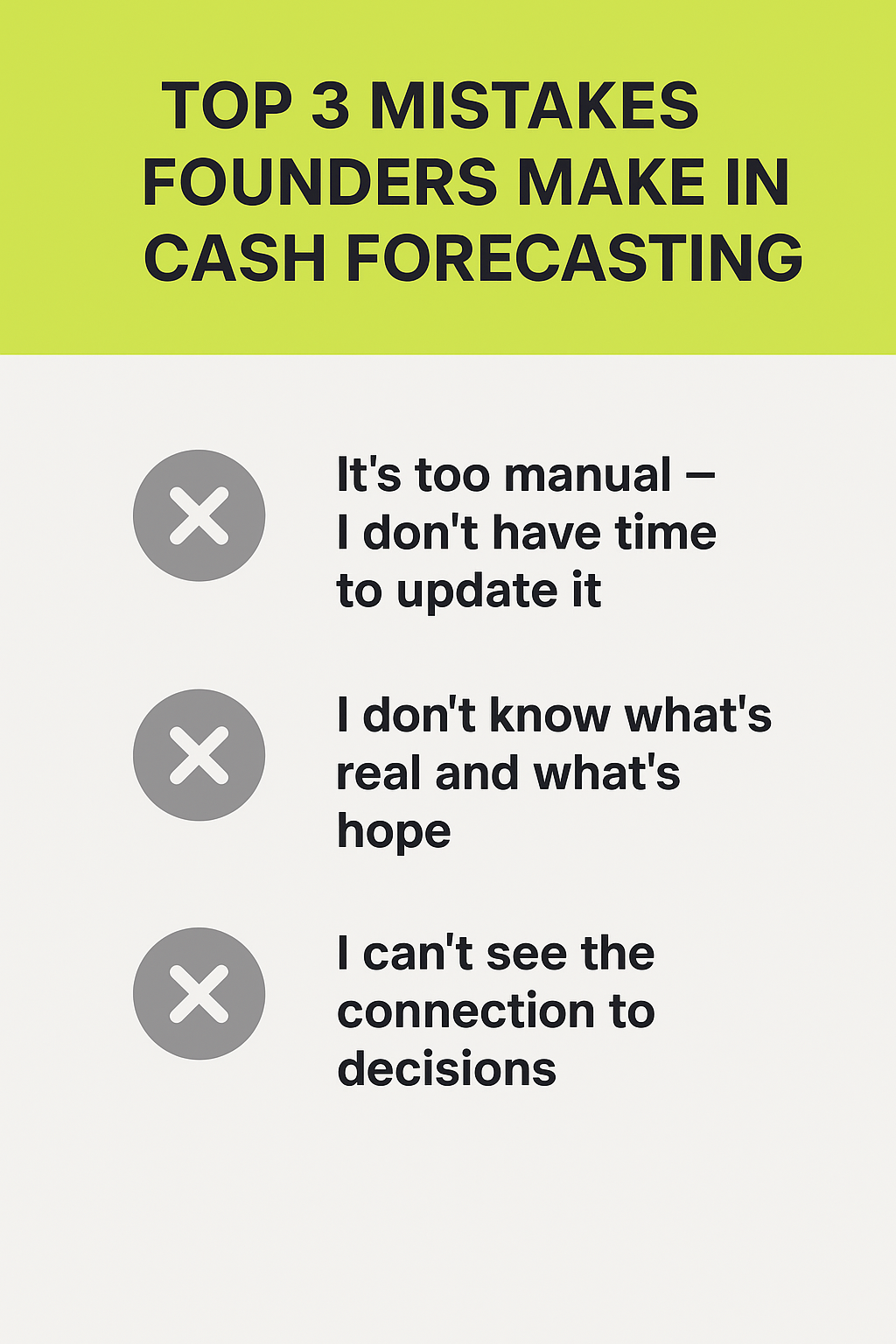Cash flow forecasting isn’t just a financial hygiene habit — it’s a strategic tool.
Many founders believe that so long as the monthly budget balances, they’re on solid footing. But business doesn’t move monthly — it moves weekly (even daily in some very fast pace industries). Suppliers get nervous on Tuesday, not at month-end. A cash shortfall on week 9 won’t show up on your P&L until it’s too late.
This is why we build and maintain a 13-week rolling cash flow plan with every Quantro client — regardless of whether they’re flush with funding or tightening belts. It gives us time to see the issues coming, space to act, and the confidence to grab opportunities that short-term cash control makes possible.
Whether you're running a real estate development cycle, a SaaS startup burning investor cash, or a scaling agency juggling payroll and pipeline, a 13-week view gives you clarity today — not regret tomorrow.
At its core, a 13-week cash flow forecast is a short-term, rolling view of your expected cash inflows and outflows, updated weekly. Rather than thinking in months or quarters, this tool lets you plan your business’s financial reality on a week-by-week basis for the next 3 months.
You’re not just looking at profit or loss (which doesn’t include VAT element init). You’re looking at actual cash movement: when invoices are expected to land, when suppliers will demand payment, when VAT is due, when salaries hit the bank. It’s granular. It’s live. And it’s actionable.
Unlike static monthly budgets, the 13-week model forces founders to connect daily decisions with immediate cash impact. It’s not about forecasting perfectly — it’s about being directionally correct and having time to act. Each week, you roll it forward one week, incorporating the latest receivables, payables, and any adjustments in timing.
It becomes your cash radar — and in business, visibility is everything.

There’s a myth that cash flow forecasting is only useful when things go wrong. In reality, a 13-week forecast is equally powerful when things are going right.
For funded companies — especially in SaaS or product-based startups — the 13-week view gives clarity on burn rate and runway. It answers key questions like: Can we afford to hire next month? When do we need the next funding round? Are we spending ahead of plan? It brings discipline without limiting ambition.
For fast-growing companies, this level of visibility enables better strategic timing. Let’s say you want to invest in new inventory, equipment, or marketing — the weekly forecast tells you when you’ll have the cash, or whether you can restructure payments to make it work. And for businesses that are cash-rich? That’s when timing matters most — using excess liquidity to negotiate better supplier terms, prepay obligations, or even capitalise on competitor weakness.
Even distressed businesses benefit: if you’re facing tight cash, the 13-week model buys time and shows you your levers— whether it’s delaying a non-critical expense, accelerating collections, or securing a short-term facility before the squeeze becomes existential.
In short, every business has something to gain from knowing what the next 90 days look like — not just where the year is going.
At Quantro, we’ve seen first-hand how a 13-week cash flow plan turns uncertainty into opportunity. Here are two real cases from our own clients:
🟢 Case 1: Securing funding before the storm hit
One of our clients was showing strong revenue, but our 13-week forecast spotted a looming cash gap — still eight weeks away. Because we saw it early, we were able to prepare financials, speak to lenders, and secure a loan before the situation became urgent.
The result? The client got better terms, faster approval, and avoided the classic last-minute financing panic that often leads to higher costs or missed opportunities.
🟢 Case 2: Using surplus cash to negotiate better terms
In another case, a client had a healthier-than-expected cash position. Most businesses would sit on that buffer. But because we had full visibility through the 13-week model, we analysed the opportunity cost of idle cash and realised we could negotiate early payment discounts.
We approached a key supplier and secured a 7% discount by paying in advance — a decision that wouldn’t have been made without that week-level confidence in available cash.
These aren’t dramatic turnaround stories. They’re strategic wins — and that’s the point. Cash flow visibility isn't just about survival. It's about timing, leverage, and control.
The power of a 13-week forecast comes from its rhythm — but the effectiveness lies in what you track and how reliably you update it.
At Quantro, we build every 13-week cash flow model starting with a detailed budget. That gives us the “ideal case.” From there, we track and adjust weekly based on actual activity, not assumptions. Here’s what we focus on every single week:
We break AR down into four buckets:
Each one has its own strategy. Recent invoices might just need reminders. Older ones might require escalation or factoring. Crucially, if key receivables don’t land, we don’t make corresponding payments — simple but powerful logic that keeps control centralised.
We track weekly obligations and match them to realistic inflows. No auto-payments unless cash is available. This weekly discipline prevents cascading issues like overdrafts or missed salaries.
We include all non-negotiables — VAT filings, tax prepayments, salary cycles. These are often forgotten until it’s too late, but in our model they’re always visible.
Once the budget is in place, we automate the full structure:
We built this for our clients at Quantro so they never ask “how much cash do we have left?” — they already know, and more importantly, they know when they’ll need more.

Most founders don’t resist cash flow forecasting because they think it’s a bad idea — they resist it because they’ve experienced it as a manual, clunky process that’s always out of date.
Here are the most common challenges we see:
❌ “It’s too manual – I don’t have time to update it.”
Without structure, weekly forecasting turns into spreadsheet chaos. People rely on static files, copy-paste errors, and best guesses. That’s why we always start from a budget — not a blank page — and build automation on top.
❌ “I don’t know what’s real and what’s hope.”
Founders often mix up confirmed cash inflows with expected ones. That’s why we track AR in aged buckets and only count cash we’re confident in. You need to know the difference between “booked revenue” and “actual cash next Tuesday.”
❌ “I can’t see the connection to decisions.”
Even when founders have a cash forecast, they don’t link it to strategy. Should you hire? Buy inventory? Delay a payment? Cash flow tools must inform decision-making, not just compliance reporting.
The fix isn’t more accounting — it’s smarter financial design.
When done right, a 13-week forecast runs in the background, alerts you before trouble, and empowers you before action.

In business, cash doesn’t move monthly — it moves weekly. And yet too many founders fly blind with outdated, static views of their finances. A 13-week cash flow forecast isn’t just a defensive tool for distressed companies — it’s a strategic system for every business, at any stage.
Whether you're managing a burn rate, expanding into new projects, or negotiating supplier terms, clarity over the next 90 days empowers better decisions today. It protects you from the downside and positions you to seize upside. It replaces panic with planning.
At Quantro, we believe every founder should know exactly when they’ll run out of cash — and exactly what to do before they get there. Weekly forecasting doesn’t just show you what’s coming. It gives you time to do something about it. Want to implement a 13-week cash forecast for your business? Let’s build it together.
More from Quantro
Innovative cash flow management strategies are crucial for any business's survival and growth. In this blog, we cover optimising payment cycles, using financial tools for passive income, leveraging technology for real-time insights, and building a cash-savvy culture. The article provides practical advice, aiming to transform routine financial management into a strategic asset that enhances operational efficiency and financial stability, equipping businesses to navigate complex economic landscapes effectively.
Read More →Explore the complexities of scaling operations in service businesses. We look into recognising the right time to scale, addressing operational challenges, leveraging technology efficiently, maintaining exceptional customer experience, and managing team dynamics effectively. We use practical examples of how to use key performance indicators to navigate growth and ensure that your business not only expands in size but also enhances its capabilities and maintains its core values. Perfect for business leaders seeking to understand the nuances of sustainable growth in the service sector.
Read More →